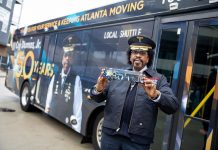Standing on the platform of the Dunwoody station one late January morning, Keith Parker looks every bit the high-ranking executive—camel overcoat, dapper gray suit, trim goatee—except for one small detail: a broken-in leather briefcase that appears to have seen the floors of a few train cars.
Before assuming MARTA’s top post last December, Parker, the former head of San Antonio’s transit authority, delighted Atlanta transit supporters by pledging to commute on the system every day. Who doesn’t love the idea of the MARTA boss sprinting to catch the train, missing it, and settling in for a quarter-hour wait?
But Parker, while copping to familiarity with that scenario, finds driving far more stressful. “When I’m forced to drive, I feel like I’ve gotten the day off to a really bad start,” he says as the crowded train car trundles toward Lindbergh Center. His wife Dawn often drops him at the station, and he spends the eleven-minute ride catching up on Twitter (follow him at @CEOMARTA). Two or three times a week, he says, fellow passengers recognize him and share their feedback—and grievances.
There’s plenty to gripe about. In the last five years, with revenues from the Fulton-DeKalb penny sales tax slumping, the agency slashed more than forty bus routes and twice cut the frequency of trains, even as the fare rose from $1.75 to $2.50. On a Gold Line train the next day, fifteen-year rider Jessica Jones—who doesn’t own a car—suggests management use the system during weekend track repairs. “Have them ride the train on Saturday when they’re single-tracking and running every thirty minutes.”
Even after the service cutbacks and fare hikes, MARTA operates at an annual loss of some $30 million and, according to a KPMG audit, will exhaust its reserves by 2018 unless drastic changes are made. The 114-page study, commissioned by MARTA, offers tough prescriptions—including renegotiating benefits packages and privatizing several functions. But it doesn’t factor in upping the frequency of buses or trains. Parker says he intends to optimize bus service within existing constraints and to find “every way possible to dramatically reduce or avoid altogether” a 25-cent fare increase presently budgeted to kick in July 1.
You don’t get to be a transit executive if funding crises faze you. Parker left San Antonio when it was in the midst of a taxation debate over a planned streetcar (the project is moving forward)—which should make him feel right at home here. The path of privatization is familiar, too; Charlotte’s system, which he previously headed, outsources bus drivers, security, and other tasks. But his biggest challenge can’t be crunched on a spreadsheet: how to convince a culturally splintered, auto-centric town that MARTA matters. Walking through all-too-quiet Lindbergh City Center, he paints Atlanta as the last kid at the car party, where “there are still people who believe mass transit isn’t a part of the overall transportation solution.”
Parker, who eschews elevators, waves at the security desk, crosses the atrium to the stairwell, and begins the six flights to his office. It’s going to be a long climb.
This article originally appeared in our April 2013 issue.














